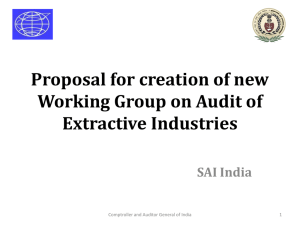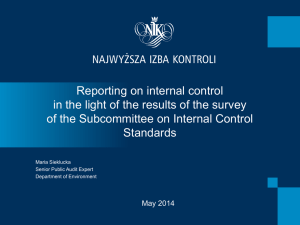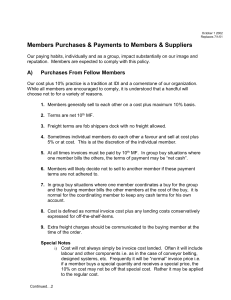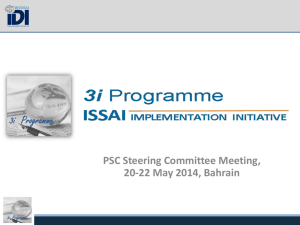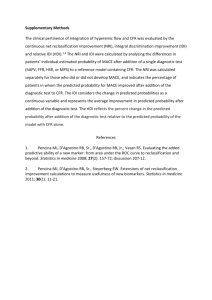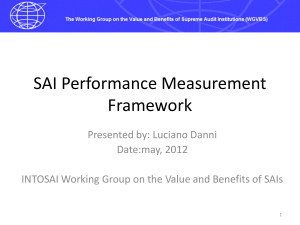IDI report for the 5th Meeting of the INTOSAI KSC Steering
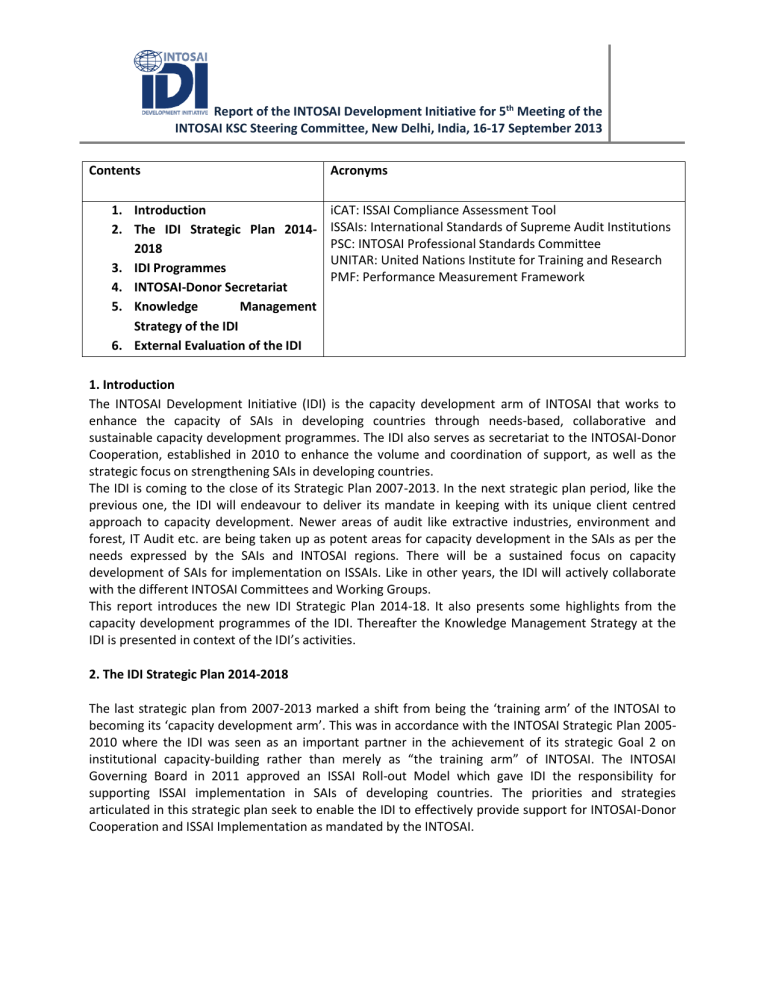
Report of the INTOSAI Development Initiative for 5 th Meeting of the
INTOSAI KSC Steering Committee, New Delhi, India, 16-17 September 2013
Contents Acronyms
1.
Introduction
2.
The IDI Strategic Plan 2014-
2018
3.
IDI Programmes
4.
INTOSAI-Donor Secretariat
5.
Knowledge
Strategy of the IDI
Management
6.
External Evaluation of the IDI iCAT: ISSAI Compliance Assessment Tool
ISSAIs: International Standards of Supreme Audit Institutions
PSC: INTOSAI Professional Standards Committee
UNITAR: United Nations Institute for Training and Research
PMF: Performance Measurement Framework
1. Introduction
The INTOSAI Development Initiative (IDI) is the capacity development arm of INTOSAI that works to enhance the capacity of SAIs in developing countries through needs-based, collaborative and sustainable capacity development programmes. The IDI also serves as secretariat to the INTOSAI-Donor
Cooperation, established in 2010 to enhance the volume and coordination of support, as well as the strategic focus on strengthening SAIs in developing countries.
The IDI is coming to the close of its Strategic Plan 2007-2013. In the next strategic plan period, like the previous one, the IDI will endeavour to deliver its mandate in keeping with its unique client centred approach to capacity development. Newer areas of audit like extractive industries, environment and forest, IT Audit etc. are being taken up as potent areas for capacity development in the SAIs as per the needs expressed by the SAIs and INTOSAI regions. There will be a sustained focus on capacity development of SAIs for implementation on ISSAIs. Like in other years, the IDI will actively collaborate with the different INTOSAI Committees and Working Groups.
This report introduces the new IDI Strategic Plan 2014-18. It also presents some highlights from the capacity development programmes of the IDI. Thereafter the Knowledge Management Strategy at the
IDI is presented in context of the IDI’s activities.
2. The IDI Strategic Plan 2014-2018
The last strategic plan from 2007-2013 marked a shift from being the ‘training arm’ of the INTOSAI to becoming its ‘capacity development arm’. This was in accordance with the INTOSAI Strategic Plan 2005-
2010 where the IDI was seen as an important partner in the achievement of its strategic Goal 2 on institutional capacity-building rather than merely as “the training arm” of INTOSAI. The INTOSAI
Governing Board in 2011 approved an ISSAI Roll-out Model which gave IDI the responsibility for supporting ISSAI implementation in SAIs of developing countries. The priorities and strategies articulated in this strategic plan seek to enable the IDI to effectively provide support for INTOSAI-Donor
Cooperation and ISSAI Implementation as mandated by the INTOSAI.
Snapshot of IDI Strategic Plan 2014 – 2018
Strategic Priorities
What value creation of SAIs will the IDI contribute to?
SP1. Strengthening the accountability, integrity and transparency of government and public entities
SP2. Demonstrating ongoing relevance to citizens and other stakeholders
SP3. Leading by example
IDI Strategy
IDI Outcomes
What outcomes will the IDI aim for in creating value for SAIs?
IS1. Effective SAI capacity development programmes
IS2. Global Public Goods used by stakeholders
IS3. Stronger regional bodies, networks and communities
IS4.Scaled up and more effective support to SAIs
Implementation Strategies
The following strategies will be used to support higher level IDI outcomes
Engage in continuing research and development activities in emerging areas.
Contribute to advocacy of SAIs for their institutional development
Leverage IT to provide effective and cost efficient professional tools and learning solutions
Promote and support gender mainstreaming by SAIs
Support SAIs in having professionally accredited personnel
Increase outreach by also providing capacity development support on cost recovery basis
Strengthen coordination of SAI capacity development support
Enhance capacity for measurement of SAI Performance
Draw on peer-peer cooperation of client SAIs for supporting capacity development
Strengthen needs assessment, follow up, monitoring and evaluation mechanism for IDI
IDI Capacity
What capacity does IDI need to achieve excellence in service delivery?
IC1. A clear and streamlined organizational and governance structure
IC2. Stability and adequacy of funds
IC3. A well integrated and managed Secretariat
IC4. Better communication of the value and benefits of the IDI approach
IC5. A multidisciplinary, professional, motivated and (sufficient) team
IC6. Strong stakeholder relations
IC7. Enhanced capacity in research, diagnostics, evaluation and IT
3. IDI Programmes i. ISSAI Implementation Initiative (3i Programme)
This programme is intended for developing countries. The first phase launched by the IDI will run from
2012 to 2014 for the SAIs of English speaking regions ASOSAI, AFROSAI-E, EUROSAI, CAROSAI and PASAI.
The IDI has plans to deliver similar activities in Arabic, French and Spanish. The programme is being launched in the OLACEPS and ARABOSAI regions.
2
To secure the necessary expertise for the programme, IDI has partnered with the INTOSAI Professional
Standards Committee and its sub-committees, INTOSAI Capacity Building Committee, the INTOSAI regions and other professional bodies. The main focus is on the implementation of the ISSAIs at level 2 and level 4 of the framework, with emphasis on level 4 ISSAIs on financial, compliance and performance audit.
Objectives for the 3i Programme – Phase I
The first phase of the 3i Programme covers level 2 ISSAIs and level 4 ISSAIs in financial, performance and compliance audit and aims to a) Assist SAIs in identifying implementation needs b) Create capacity for implementation of level 2 and level 4 ISSAIs in financial, performance and compliance audit through global public goods and ISSAI facilitators at global, regional and SAI level. c) Facilitate startup of SAI level implementation by providing support for assessing implementation needs at SAI level to develop ISSAI Implementation strategies, ISSAI based cooperative audits and other startup activities that SAIs may undertake based on their strategy. d) Create an active knowledge community through a web based knowledge portal for ISSAI implementation networks and wider outreach
Strategy for 3i Programme implementation
These objectives of Phase 1 of the 3i Programme will be achieved through a results framework that consists of five elements at the global, regional and SAI level. While the same results framework will be used for all INTOSAI regions, the scope and programme activities may vary depending on the needs of the region.
Progress till date:
First version of iCATs in financial, performance and compliance audit developed by global team of ISSAI experts and mentors. iCATs on financial, performance and compliance audit are detailed mapping tools for
SAIs to map their existing practices to ISSAI requirements and determine ISSAI implementation strategy
ISSAI Certification programme designed for financial, performance and compliance audit.261 participants from 67 SAIs in five English speaking INTOSAI regions enrolled for the e-course on iCATs. 230 participants successfully completed the e-course on the UNITAR Platform. Thereafter, two E-courses on
Implementing ISSAIs (Financial and Performance Audit) have been conducted for the successful participants of the first round.
ISSAI Implementation Handbook- Performance Audit and ISSAI Implementation Handbook-
Performance Audit have been developed.
iCATs disseminated through 3i Management Workshops to 44 Heads of SAIs+ 4 Heads of Sub National
Audit Offices and 135 Senior Management staff from 77 SAIs+ 4 Sub National Audit Offices in CAROSAI
(14), AFROSAI-E (20) , PASAI (14 + 2 Sub National Audit Offices), ASOSAI (20) and EUROSAI (9+ 2 Sub national offices).
Operating network of ISSAI experts and mentors for financial, performance and compliance audit created.
3
3i Community Portal has been launched and is available at http://www.idicommunity.org/3i/ . The portal provides for a wider outreach in the INTOSAI community. It aims to create communities of practice for ISSAI implementation by providing a platform for knowledge creation, knowledge sharing, interaction and support related to ISSAI implementation. ii. Risk Based Approach to Financial Audit (RBAFA)
As part of the IDI’s efforts to assist the SAIs in implementation of INTOSAI Auditing Standards (ISSAIs), the IDI is launching another round of E-learning course on Risk-based Approach to Financial Audit
(RBAFA) in cooperation with the UNITAR). The programme aims to enhance awareness of the ISSAIs pertaining to financial audit, with a particular emphasis on providing training to financial auditors in using tools for adopting a risk-based approach to financial audit. iii. Public Debt Auditing Programme
The recent global financial crises have once again increased awareness in the developing countries of the importance of managing their external obligations. A sound public financial management system, including borrowing and lending practices by sovereigns and its oversight, is an inevitable solution to the debt problems. The IDI, the INTOSAI Working Group on Public Debt Audit (WGPD)and the UNCTAD are collaborating on design, development and conduct of a capacity building programme for the SAIs for strengthening public sector oversight and audit of sovereign lending and borrowing frameworks. iv. Support to the INTOSAI Capacity Building Committee
UK’s Department for International Development (DFID) has provided funding support for a programme to strengthen developing country participation in the INTOSAI Capacity Building Committee (CBC) and for dissemination of CBC guidance on various aspects of SAI capacity building. This programme was launched in 2012 as cooperation between the IDI and the INTOSAI CBC. v. IT Audit Programme
The programme aims at updating the knowledge and skills of the SAI staff based on the ISSAIs, guidance from INTOSAI Working Group on IT Audit (WGITA) and other accepted IT standards and frameworks like the ISACA and COBIT. The programme focuses on SAI staff at all levels who are engaged in IT audit. The programme was launched as a pilot in the AFROSAI-E region in 2012 and it will continue into 2013. IT
Audit Handbook for SAIs has been developed jointly by the IDI and WGITA and will be presented for approval during the INTOSAI Congress.
4. The INTOSAI-Donor Secretariat
The INTOSAI-Donor Cooperation is making good progress in its work to increase strategic focus and coordination for Donors and the SAI community in strengthening SAI capacity in developing countries.
4
Since the initial signing of the Memorandum of Understanding in 2009, the number of donors now stands at 19.
Other activities include:
A.
SAI Capacity Development Database
In January 2012, a SAI Capacity Development Database on support to the SAI community was launched to enhance coordination of support. By July 2013 close to 270 projects had been registered by SAIs,
INTOSAI Regions and other INTOSAI bodies, donors and private sector suppliers. The database has been used for analytical purposes (including estimation of the total level of SAI capacity development support) as well as for coordination purposes in the process of matching project proposals from the 2011 Global
Call for Proposals with providers of support.
B.
Global Call for Proposals- Launch of 2013 Global Call for Proposals
During the fifth INTOSAI-Donor Steering Committee meeting in October 2012, it was decided that the
Global Calls for Proposals for SAI capacity development proposals in need of support will be carried out annually at fixed intervals. The second Global Call for Proposals will be launched at the 6th INTOSAI-
Donor Steering Committee meeting on 19-20th October 2013 in Beijing, China. Eligible applicants are
SAIs in ODA eligible countries, as well as INTOSAI Regions/Sub-Regions, and INTOSAI Committees,
Subcommittees and Working Groups which submit proposals for capacity development initiatives designed to predominantly benefit SAIs in ODA eligible countries.
In the first round, 55 proposals were submitted globally. While the matching process is still ongoing, to date 12 proposals have resulted in projects in progress, another three have had financing approved, and there is ongoing dialogue between the applicant and development partners on a further 14 proposals.
C.
Establish SAI Capacity Development Fund
Work has also continued on the development of a global pooled fund (SAI CDF), which would complement existing bilateral arrangements. Operating procedures have been completed and funding is currently being sought from interested donors.
D.
SAI Performance Measurement Framework
A framework to measure SAI Performance (SAI PMF) has been developed by a Task Team under the auspices of the Working Group on the Value and Benefits of SAIs (WGVBS).
The Secretariat is coordinating the Task Team that is developing the framework on behalf of the WGVBS. After a first phase of piloting and consultation of the framework, a Pilot Version was endorsed by the WGVBS during its 6 th meeting in Lima, 3-5 July 2013 to go through a second and wider round of piloting, where 20-30
SAIs will go through the assessment.
The SAI PMF gives a holistic, high-level assessment of SAI performance by combining objective measurement and qualitative professional judgment. The assessment will measure SAI performance in the country context and aims at identifying the SAIs impact, value and benefits to society. SAI PMF is a global public good, accessible to all SAIs but with the decision on whether or not to use it, resting with the SAI itself.
Assessments may be carried out for a variety of purposes, including:
As a tool to learn from other peers within the same region or with similar characteristics
5
As an input to a SAIs internal performance management system
Contributing to SAIs efforts to regularly assess and report on their own performance.
Demonstrating to external stakeholders the value and benefits of the SAIs work
Demonstrating to providers of support that performance has improved over time and that resources provided for SAI capacity development have delivered the desired performance results
Input to the SAIs capacity development cycle (e.g. identifying strengths and weaknesses before a new strategic planning process)
How an assessment is conducted and who is tasked with the assessment depends on the purpose of the assessment. The SAI PMF is therefore designed equally for all approaches, and could be conducted as a self assessment, peer assessment or external assessment.
5. Knowledge Management Strategy of the IDI
The IDI adopted its Knowledge Management Strategy Paper in July 2009. The strategy primarily devolved around Goal 3 of the IDI Strategic Plan 2007-2012 which endeavoured ‘To contribute to SAIs knowledge sharing efforts’. The IDI has recruited a new Knowledge Manager on secondment from SAI, India in
October 2012. Based on the Knowledge Management Strategy, the Knowledge Management Work Plan
2013 has been operationalised.
The Knowledge Management Action Areas and salient initiatives under each of those are listed below.
I.
Document the KM requirements of all internal and external stakeholders. a.
Recognise all external and internal stakeholders b.
Recognise their knowledge requirements
II.
Create Knowledge Resources for use of External and Internal Stakeholders a.
External Stakeholders
Capacity Building Products delivered through conventional means and e-courses
Articles, Papers and other contribution to Journals, Magazines etc.
IDI Newsletter in addition to the INTOSAI-Donor Secretariat newsletter b.
Internal Stakeholders
Directory of Experts
Training Programmes
III.
Organise Knowledge Resources a.
Notifying new Knowledge Resources and update the Programme/ Project details on MS
Sharepoint application being used for IDI Programmes and IDI website b.
Weeding out obsolete Knowledge Resources c.
Inventorise Knowledge Resources d.
Archiving
IV.
Disseminate Knowledge Resources
6
a.
IDI Communication Strategy b.
Instruments for dissemination
3i Community Portal
Virtual Community for the RBAFA Programme
IDI Website
My IDI
V.
Application of Knowledge Resources a.
‘Application’ for explicit knowledge
Strategic Plans through SP Programme
Cooperative/Joint Audits b.
‘Feedback’ for tacit knowledge
6. External Evaluation of the IDI
External evaluation of the IDI was conducted by the Swedish Development Advisers during 2013. The evaluation covered the review and implementation of the IDI Strategic Plan 2007-2013. The report has covered issues like the IDI’s mandate, governance and operational planning. It has examined the IDI’s programmes as also the working of the INTOSAI Donor Secretariat. The report would be available on the
IDI website: www.idi.no
.
7
